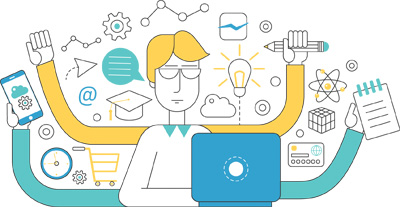It didn’t used to be like this. Not long ago, you advertised, customers bought. Correspondence came by mail. But the rise of social media and the always-on Internet have put everything from customer rants to trade secrets into the hands of anyone with a computer or a smart phone. These days, negative word-of-mouth can cost a business dearly.
Consider a recent Google search for a $10 billion bank that yielded only three mentions of the bank on the first page of search results, including a consumer Yelp! review denigrating the bank as “….Not even worthy of one star. [They] have obscene fees.” A competitor’s ad appeared above the bank (a regional competitor had purchased their brand name as a keyword). These damaging references were available to anyone, including prospects, customers, investors and the media.
Unfortunately, this bank is representative of many businesses today. They’ve yet to catch on to the fact that, no matter what product or service you provide, your customers are savvy, demanding, less loyal and more connected than ever. If they don’t get what they want from you, they’ll get it from your competition.
The costs of ignoring the customer experience are immense. In 2009, 86 percent of consumers stopped doing business with an organization after a bad customer experience, up 27 percent from four years earlier. The cost of acquiring customers—and the danger of losing them—is high (acquiring a new customer can cost up to six or seven times more than retaining a current one) and the price of poor experiences can shutter your doors.
Fortunately, recognition of the critical nature of customer experience has been building. Recent research shows that 90 percent of executives in the United States feel customer experience is “very important” or “critical” to their firm’s strategy in the coming years. Those organizations that track customer experience seriously can enjoy 40 percent better marketing performance than those that don’t—and see 35 times more leads in their sales pipeline that result in closed business.
Embracing—and profiting from—this new reality starts by accepting that customer experience isn’t defined by you. It’s defined by your customers.
Taking charge of customer experience
What can companies do to deliver a differentiated customer experience in a world where customer expectations are changing as fast as their loyalty is declining? It starts by accepting that customer experience is no longer within your complete control, but is now defined by how your organization is perceived by your customers.
These perceptions—the foundation of customer experience—occur at every point of contact between your company and your customers. Online and off, in-person or not, every interaction between or about your organization and any member of your audience universe is a touchpoint: salespeople, packaging, advertisements, manuals, customer service centers, invoices, catalogs, thank-you letters and even your products. The list goes on. Today, complex, interconnected touchpoints occur at every single point of interaction between you and your customers. All you need to do is check out Yelp! or recognize that Facebook and the iPhone didn’t exist just a few years ago. The velocity of change is staggering.
Over the next five years, a lack of customer touchpoint awareness will leave the door wide open to brand erosion and smarter competition. Even so, most companies don’t have a complete picture of their existing interactions or touchpoints—even the ones they control. To improve them, your organization must evaluate how your brand touches, influences and serves customers by identifying, measuring and understanding the critical touchpoints that drive desired customer experiences and business results.
So where do you start?
First, identify your touchpoints. How are you connecting with your customers? Answering this question in detail will help you leverage new insights to chart a path to where you need to be tomorrow. This exercise is called “Touchpoint Mapping” and will help create a map of where you are today.
Among other key measures, your Touchpoint Map should highlight:
• The “moments of truth” where you interact with customers;
• All touchpoints at each interaction, including categorization by type (human, interactive or static);
• How touchpoints work individually, or in sequence (“touchpoint paths”) to move customers through the relationship life-cycle and closer to your company;
• The most important touchpoints regarding acquisition and retention, value to your business and to customers, revenue generation (or cost savings), efficacy at meeting both business and customer needs, gaps where touchpoints should exist but don’t and redundancies where touchpoints exist but shouldn’t.
Create more loyal—and profitable—customers
By looking at its customer experience through the lens of a Touchpoint Map, a telecom discovered that direct mail it was sending post-installation, with the intention of providing valuable information to customers, was actually making the customers unhappy. By cutting this out, it saved nearly $1 million per year—and increased customer satisfaction at the same time.
A bank discovered that something as simple as doggie treats at the drive-through had the ability to boost loyalty significantly. When the teller who brought the treats from home was laid off, the treats stopped—and the outcry began. Now, every branch has doggie treats—and improved satisfaction and loyalty scores to boot. The examples are endless. Your company probably has opportunities like this as well—you just need to know how to look for them.
With this data in hand, you’ll have a roadmap for constructing a specific plan to move forward. A plan that helps set priorities, maps out costs and benefits and provides specific metrics for measuring results. Perhaps most important, this map is an opportunity for organizations to measure and quantify the effectiveness of each touchpoint and its ability to positively (or negatively) influence the customer experience.
Ask yourself: “In 2015, will we be in closer touch with our customers than our competitors will be?” The best way to answer is by knowing the answer to this one: “What is our customer experience, and how can we improve it?”
Michael Hinshaw is managing director of www.mcorpconsulting.com, a San Francisco-based firm that grows customer value by improvin customer experience. He pioneered Touchpoint Mapping, a trademarked process that helps companies—from fst-growth market leaders to the Fortune 100—get closer to their customers and profit significantly as a result. You can reach him at (415) 526-2651 or mhinshaw@mcorpconsulating.



